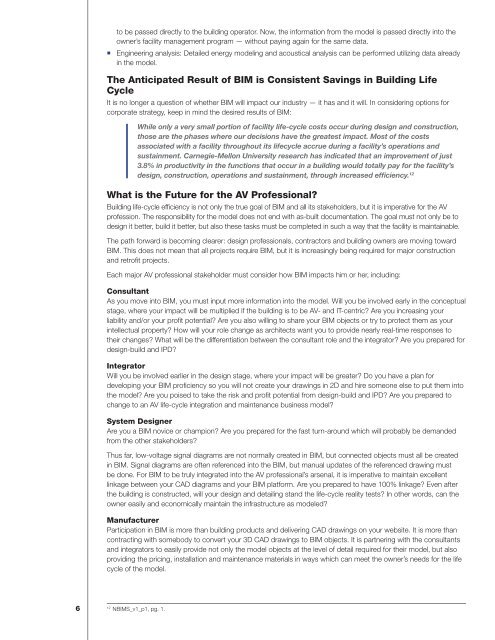Building Information Modeling (BIM) - InfoComm International
Building Information Modeling (BIM) - InfoComm International
Building Information Modeling (BIM) - InfoComm International
Create successful ePaper yourself
Turn your PDF publications into a flip-book with our unique Google optimized e-Paper software.
6<br />
to be passed directly to the building operator. Now, the information from the model is passed directly into the<br />
owner’s facility management program — without paying again for the same data.<br />
Engineering analysis: Detailed energy modeling and acoustical analysis can be performed utilizing data already<br />
in the model.<br />
The Anticipated Result of <strong>BIM</strong> is Consistent Savings in <strong>Building</strong> Life<br />
Cycle<br />
It is no longer a question of whether <strong>BIM</strong> will impact our industry — it has and it will. In considering options for<br />
corporate strategy, keep in mind the desired results of <strong>BIM</strong>:<br />
While only a very small portion of facility life-cycle costs occur during design and construction,<br />
those are the phases where our decisions have the greatest impact. Most of the costs<br />
associated with a facility throughout its lifecycle accrue during a facility’s operations and<br />
sustainment. Carnegie-Mellon University research has indicated that an improvement of just<br />
3.8% in productivity in the functions that occur in a building would totally pay for the facility’s<br />
design, construction, operations and sustainment, through increased efficiency. 12<br />
What is the Future for the AV Professional?<br />
<strong>Building</strong> life-cycle efficiency is not only the true goal of <strong>BIM</strong> and all its stakeholders, but it is imperative for the AV<br />
profession. The responsibility for the model does not end with as-built documentation. The goal must not only be to<br />
design it better, build it better, but also these tasks must be completed in such a way that the facility is maintainable.<br />
The path forward is becoming clearer: design professionals, contractors and building owners are moving toward<br />
<strong>BIM</strong>. This does not mean that all projects require <strong>BIM</strong>, but it is increasingly being required for major construction<br />
and retrofit projects.<br />
Each major AV professional stakeholder must consider how <strong>BIM</strong> impacts him or her, including:<br />
Consultant<br />
As you move into <strong>BIM</strong>, you must input more information into the model. Will you be involved early in the conceptual<br />
stage, where your impact will be multiplied if the building is to be AV- and IT-centric? Are you increasing your<br />
liability and/or your profit potential? Are you also willing to share your <strong>BIM</strong> objects or try to protect them as your<br />
intellectual property? How will your role change as architects want you to provide nearly real-time responses to<br />
their changes? What will be the differentiation between the consultant role and the integrator? Are you prepared for<br />
design-build and IPD?<br />
Integrator<br />
Will you be involved earlier in the design stage, where your impact will be greater? Do you have a plan for<br />
developing your <strong>BIM</strong> proficiency so you will not create your drawings in 2D and hire someone else to put them into<br />
the model? Are you poised to take the risk and profit potential from design-build and IPD? Are you prepared to<br />
change to an AV life-cycle integration and maintenance business model?<br />
System Designer<br />
Are you a <strong>BIM</strong> novice or champion? Are you prepared for the fast turn-around which will probably be demanded<br />
from the other stakeholders?<br />
Thus far, low-voltage signal diagrams are not normally created in <strong>BIM</strong>, but connected objects must all be created<br />
in <strong>BIM</strong>. Signal diagrams are often referenced into the <strong>BIM</strong>, but manual updates of the referenced drawing must<br />
be done. For <strong>BIM</strong> to be truly integrated into the AV professional’s arsenal, it is imperative to maintain excellent<br />
linkage between your CAD diagrams and your <strong>BIM</strong> platform. Are you prepared to have 100% linkage? Even after<br />
the building is constructed, will your design and detailing stand the life-cycle reality tests? In other words, can the<br />
owner easily and economically maintain the infrastructure as modeled?<br />
Manufacturer<br />
Participation in <strong>BIM</strong> is more than building products and delivering CAD drawings on your website. It is more than<br />
contracting with somebody to convert your 3D CAD drawings to <strong>BIM</strong> objects. It is partnering with the consultants<br />
and integrators to easily provide not only the model objects at the level of detail required for their model, but also<br />
providing the pricing, installation and maintenance materials in ways which can meet the owner’s needs for the life<br />
cycle of the model.<br />
12 N<strong>BIM</strong>S_v1_p1, pg. 1.

















